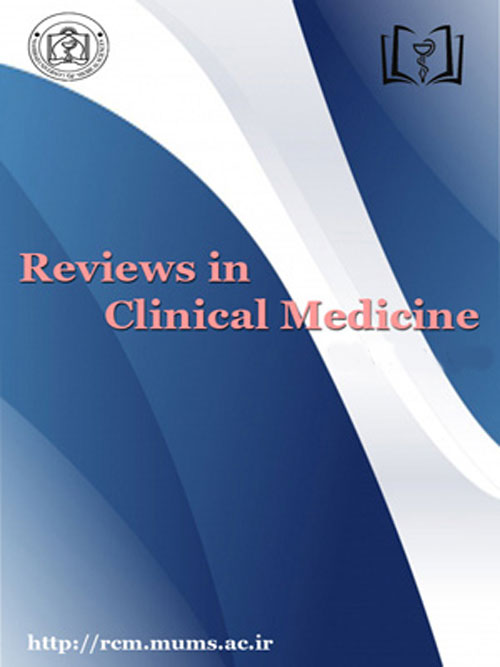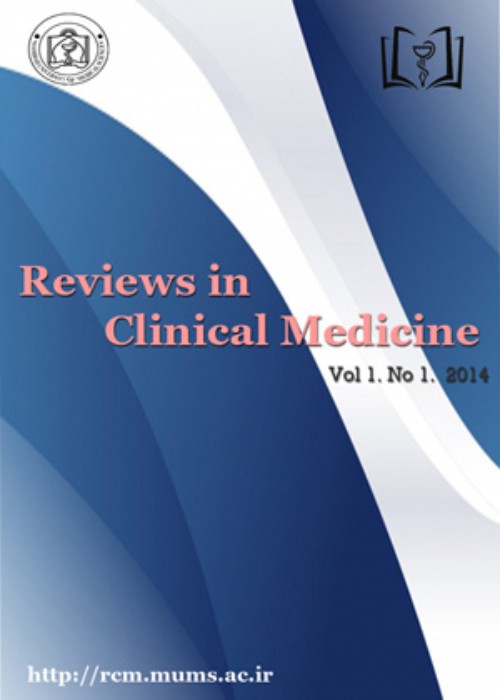فهرست مطالب

Reviews in Clinical Medicine
Volume:5 Issue: 2, Spring 2018
- تاریخ انتشار: 1397/04/20
- تعداد عناوین: 8
-
Pages 33-36Epilepsy is a major neurological disorder, which may occur in all age groups, including children. Approximately 20% of epileptic children are drug-resistant. Uncontrolled seizures pose variable risks to patients, such as increased mortality rate, trauma, and cognitive and psychiatric disorders. Therefore, effective treatment is essential to controlling seizure attacks. Although many antiepileptic drugs are currently available for clinical treatments, clinicians are concerned with the discovery of safer drugs with enhanced antiepileptic effects and fewer side-effects. Traditional medicine provides strong grounds for modern medicine. Use of some medicinal plants has been shown to reduce or prevent the further progression of epileptic seizures. The present review aimed to discuss the effectiveness of some medicinal plants in the treatment of children with intractable epilepsy. An online literature review was conducted in databases such as IranMedex, Scopus, Medline, and Google Scholar to identify the studies investigating the use of medicinal plants in children with intractable epilepsy. In addition, the files of the authors were reviewed in the reference lists and bibliographies of the retrieved articles. According to the results, herbal therapies could potentially yield new treatment options for children with intractable epilepsy. Using medicinal herbs could be a cost-efficient treatment method in these patients as a culturally acceptable option to their families.Keywords: children, Epilepsy, Plants, Seizure
-
Pages 37-41Epilepsies and epileptic syndromes are among the most common chronic neurological disorders in neonates, infants, and children. Remission occurs in 70% of epileptic children, while other cases experience frequent seizures and become refractory to various treatment modalities. Refractory seizures have a significant adverse impact on the quality of life of epileptic children and their families. Prognosis of epilepsies is determined based on the risk of seizure or convulsion recurrence. Some of the most important risk factors for recurrence are the age at seizure presentation, neurodevelopment of the child, etiology of seizures, seizure frequency before anticonvulsant withdrawal, response to antiepileptic medications, type of epileptic syndromes, and electroencephalography of the patient. Recognition of the risk factors for seizure recurrence results in the optimal management of the treatment protocols, thereby reducing the adverse effects of epileptic seizures on patients and their families. The present study aimed to provide a narrative review of the most important risk factors for the recurrence of epilepsies in children by two child neurologists.Keywords: children, Epilepsy, prognosis, Recurrence
-
Pages 42-48Autoimmune diseases are characterized by the attack of the immune system to normal tissues. Patients with autoimmune diseases usually have the deficiency of dietary factors that may be related to the etiology of these conditions. Given the role of vitamin E as a physiologic stabilizer of lysosomal membranes, its deficiency can initiate the process of autoimmune diseases or accelerate its progress. It is supposed that vitamin E could reduce oxidative stress, which is an important factor in the pathogenesis of autoimmune diseases. The literature review is indicative of a decrease in the serum levels of vitamin E in almost all autoimmune diseases. Furthermore, there is evidence regarding the possible therapeutic value of vitamin E in the management of autoimmune diseases. Owing to the anti-inflammatory and protective effect of vitamin E against free radicals, and also its important effect on cytokines levels, this vitamin may play a powerful role in the prevention and treatment of rheumatoid arthritis, as well as joint inflammation and damage. Moreover, increased vitamin E intake might decrease the incidence and severity of certain autoimmune diseases through the regulation of the immune system.Keywords: Autoimmune diseases_Vitamin E Tocopherols_Tocotrienols
-
Pages 49-53The primary aim of epilepsy treatment is seizure control, and the treatment is principally prophylactic. Although complete seizure control is the most important predictor of improved quality of life, antiepileptic drugs (AEDs) could cause severe side effects in the patients. Therefore, the risk-benefit ratio must be considered before the initiation of AED treatment. Accurate recognition and differentiation of epileptic and non-epileptic paroxysmal events and the diagnosis of the seizure type and epilepsy syndrome are essential procedures before AED treatment. It is often recommended that AED treatment start after two seizures, and being seizure-free for a minimum of two years is a prerequisite for treatment withdrawal. The AED treatment process must be initiated with a single drug at a low maintenance dose, along with further upward titration. Overall, the first attempt in AED treatment has been reported to effectively control seizures in 50-70% of the cases. Moreover, there is a consensus that being seizure-free for two years is the most valid approach to discontinue AED treatment. Approximately 50% of the children with epilepsy outgrow their disease. The present study aimed to provide a systematic method for the treatment and management of epilepsy in children.Keywords: Antiepileptic Drugs, Epilepsy, Quality of life
-
Pages 54-58The preferred desire of orthopedic surgeons is to preserve the femoral head in the early stages of femoral head osteonecrosis; however, hip arthroplasty is needed in most cases. The outcomes of traditional surgical treatments alone are not favorable. Thus, femoral head osteonecrosis frequently follows an unpredictable course resulting in significant hip arthritis. Through the years, it has been identified that decreased proliferation capacity and content of bone marrow stem cells (BMSCs) in the femoral head region play a key role in the pathogenesis of osteonecrosis of femoral head (ONFH). In the past two decades, researchers have focused on cell-based therapies for ONFH treatment. The regenerative potential of damaged cartilage and bone tissue with stem cells has become a new treatment approach in the field of orthopedics. Ongoing basic science and clinical studies are progressing toward efficient standard treatment options for this extremely challenging condition. In this article, we reviewed the recently developed methods of cell therapy for these types of musculoskeletal conditions.Keywords: Cell therapy, Femoral head, Osteonecrosis, Stem cell
-
Pages 59-66Epilepsy is a common neurological disorder in childhood with prominent neurological manifestations, signs, and symptoms in inherited neurometabolic disorders. Accurate diagnosis of neurometabolic disorders in epileptic patients increases the possibility of a specific treatment to improve epilepsy. Therefore, early diagnosis is essential in potentially treatable epileptic disorders. Various seizure types occur in neurometabolic disorders, which are often refractory to antiepileptic drugs (without the treatment of the underlying neurometabolic disorders). Patients with underlying disorders have severe clinical presentations, such as refractory seizures. In addition, they do not respond to antiepileptic drugs in many cases. In the epileptic patients with developmental delay and/or regression, neurometabolic disorders should be considered in the presence of abnormal neurological examination and brain imaging with specific patterns. Some of these disorders are potentially treatable. Therefore, neurologists should determine the etiology of epilepsy, especially in pediatric patients, and the treatment should not be restricted to symptomatic therapy. The present study aimed to introduce some of the treatable causes of epilepsy in pediatric patients.Keywords: Brain Disorders, Epilepsy, Metabolic, Pediatrics
-
Pages 67-71Churg-Strauss syndrome (CSS) is a type of vasculitis of small-to-medium sized vessels. This syndrome is known by a history of bronchial asthma with systemic necrotizing vasculitis and peripheral blood hypereosinophilia. It is currently called eosinophilic granulomatosis with polyangiitis (EGPA). This disease affects both genders and all age groups, but it is very rare among children. CSS diagnosis is based on clinical findings such as asthma, eosinophilia, rhinosinusitis, and signs of vasculitis in major organs. In cases where steroids alone or in combination with other immunosuppressive agents are used as treatment, the outcome and long-term survival are usually satisfying. In comparison with other types of systemic vasculitis, the mortality rate of this syndrome is low. In this study, we present the case of a 7-year-old boy with poorly controlled bronchial asthma since three years of age. This case had developed purpuric skin lesions, sinusitis, arthritis, and weakness of the limbs with symptoms of mononeuritis multiplex at the age of seven. After being admitted to our hospital, a series of studies, including complete blood count-diff, chest X-ray, paranasal sinus radiography, brain magnetic resonance imaging, nerve conduction study, spirometry, and serological tests for autoantibodies, were performed and he was diagnosed with CSS. Thereafter, he received regular corticosteroid therapy in combination with methotrexate, and his symptoms were generally well-controlled with the beginning of the treatment. The clinical characteristics, diagnosis, and management of CSS in children are also reviewed in this study.Keywords: Asthma, Churg, Strauss syndrome, Mononeuritis multiplex, Vasculitis
-
Pages 72-75Meningioma is one of the most common primary brain tumors in adults. The literature indicates a higher prevalence of multiple meningiomas in women, which might be attributed to the hormonal factors, such as expression of progesterone receptor.
Here we report a 58-year-old woman with a 4-year history of headache, which was aggravated during the few months before her admission. The patient was diagnosed with multiple meningiomas based on her brain magnetic resonance imaging. Therefore, she underwent surgical excision of the tumor and had no complications or signs of recurrence in the site of surgery, after a 3-year follow-up.
Although multiple meningioma is not frequent, it does not differ from solitary tumors in terms of prognosis and management. Our experience shows that complete removal of the tumors is not possible in all cases of multiple meningioma and resection of the largest tumors results in favorable outcomes.Keywords: Brain neoplasm, Meningioma, Neurosurgery


